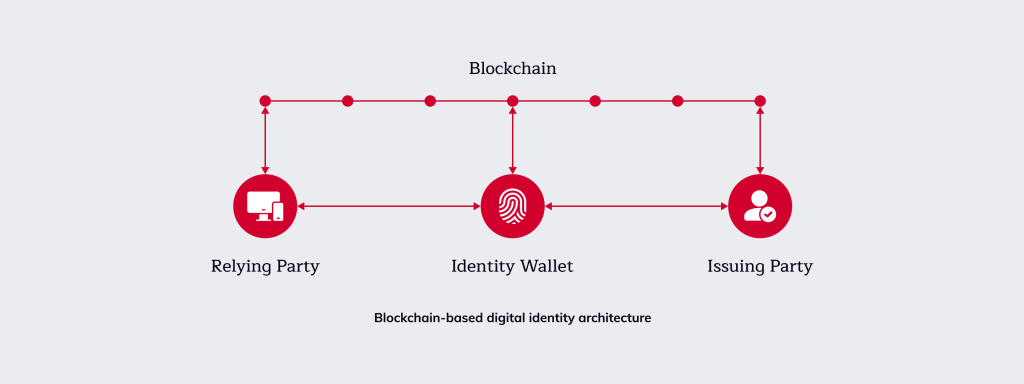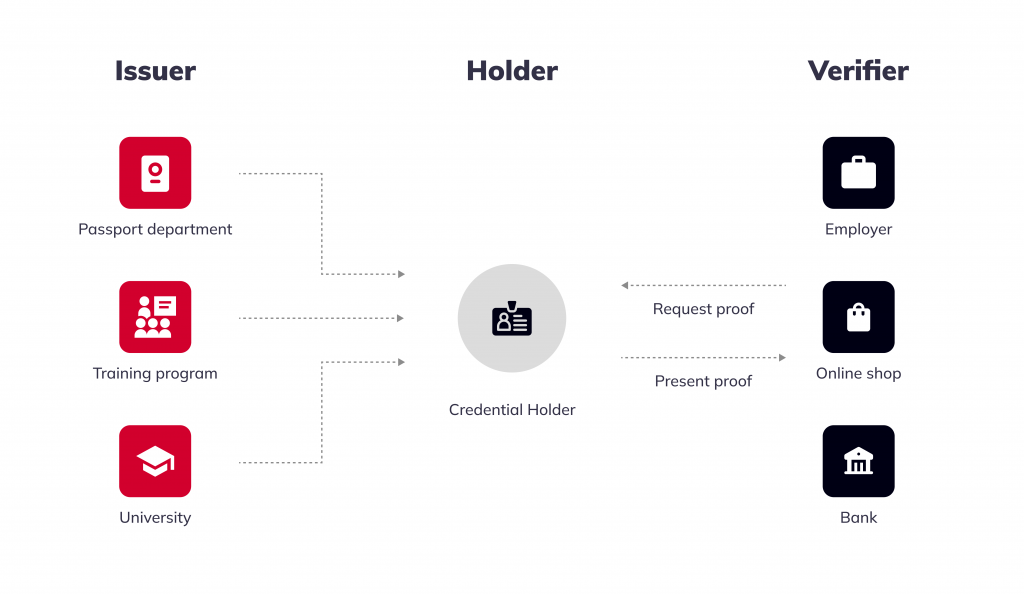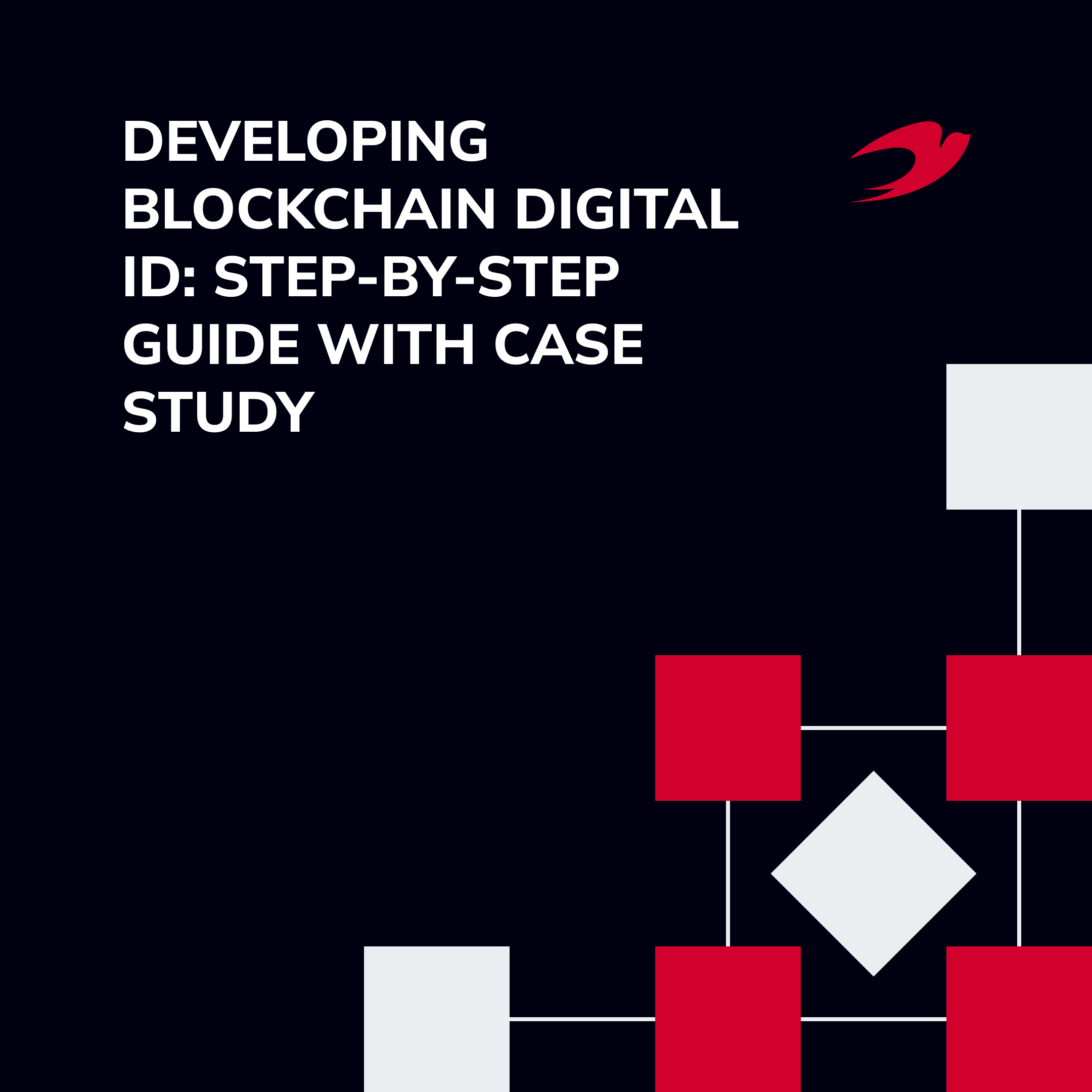There is a growing need for people to conduct their affairs, access services, or conduct transactions online. In such an environment, authentication becomes an extremely important aspect. Existing authentication mechanisms suffer from problems such as cumbersome registration and verification processes, forgotten or leaked passwords, etc.
The rise of blockchain technology offers new possibilities to solve digital identity and security problems. The goal of our article is to discuss how to build a blockchain-based digital identity system. So, let’s start.
Thinking of creating a digital ID system?
Blockchain can provide a reliable environment with the needed level of security and autonomy. Blockchain technology can be used for digital identity authentication, digital certificate issuance, electronic contract signing, etc. In terms of digital certificate issuance, blockchain can be utilized as a trusted certificate storage and verification system to ensure the authenticity and validity of certificates. Eager to learn more? Read this article or schedule your free consultation with our tech expert to understand where to implement blockchain for your digital ID solution.
Table of Contents:
- Understanding Digital Identity
- Top Challenges in Centralized Digital Identity
- Why Do We Need Blockchain for Digital Identity?
- Building the Blockchain-Based ID: A Step-by-Step Guide
- Benefits of Blockchain Digital Identity Systems
- Case Study
- Summary
Understanding Digital Identity
Digital identity is a virtual representation of your personal information. It is the key to verifying your online presence. Virtual identity allows you to confirm authenticity when conducting secure online transactions without presenting physical identity documents.
According to GMI research, the digital identity solution market size was valued at $25.2 billion in 2022 and is anticipated to register at a CAGR of 16% between 2023 and 2032. Digital identity is a part of our future that will inevitably influence how we live.
However, now centralized digital identities have several drawbacks that undermine trust in these solutions. This problem can be solved by using blockchain for digital identity management. And this is what we will discuss further.
Top Challenges in Centralized Digital Identity Management Systems
Blockchain for identity verification can play an important role. Traditional digital identity authentication methods have many problems, such as insecure data storage, susceptibility to tampering, and lack of privacy protection. Top 3 challenges in centralized digital identity management systems:
- Security vulnerabilities. Centralized digital identity management systems are susceptible to cyberattacks due to the concentration of sensitive user data in a single location. A successful breach could lead to identity theft, data leaks, and financial losses.
- Single point of failure. These systems represent a single point of failure, making them vulnerable to technical glitches or outages that can disrupt the entire identity verification process. This poses a significant risk to online services.
- Privacy concerns. Centralized systems collect and store extensive personal information. Users may be uncomfortable with a single entity having comprehensive access to their data, increasing the risk of privacy breaches.
Blockchain, as a decentralized and tamper-proof distributed ledger technology, can provide a more secure and trustworthy solution for digital identity authentication. However, it is not as easy to develop blockchain applications as it may seem.
Why Do We Need Blockchain for Digital Identity?
First, blockchain can provide decentralized identity verification. Traditional identity verification usually relies on third-party organizations, such as governments and banks, which need to collect and store users’ personal information. It has the risk of data leakage and misuse. With blockchain, on the other hand, personal identity information can be encrypted and stored safely. Each user can have his or her private key, enabling decentralized identity verification. In this way, users can better control their personal data without relying on third-party organizations for identity verification.

Second, blockchain can provide tamper-proof authentication. Each transaction on the blockchain is recorded in a block and linked with the previous block to form a tamper-proof data chain. Once identity information is stored on the blockchain, it cannot be tampered with or deleted. This prevents identity information from being fraudulently used or tampered with, increasing the security and trustworthiness of identity authentication.
In addition, blockchain can provide anonymity and privacy protection. In the traditional identity authentication process, an individual’s identity information must be disclosed to multiple organizations, which can easily lead to the leakage of personal privacy. In contrast, blockchain can achieve anonymous storage and transmission of identity information through encryption technology, and only authorized institutions can decrypt and access the relevant information. This can effectively protect users’ privacy while ensuring the reliability of identity authentication.
Currently, there are several major challenges that all existing decentralized identity protocols face. These are the lack of properly integrated AML/KYC and transaction monitoring & transaction alerting. Blockchain solutions lack standard identity verification procedures that are present now in classical banking systems. Because AML and transaction monitoring are not yet integrated, this is the biggest argument why governments are not implementing digital identity yet.
Herman Stohniiev, Co-founder and CTO at IdeaSoft
Building the Blockchain-Based Digital Identity System: A Step-by-Step Guide
Here is a step-by-step guide that unravels the layers of establishing a cutting-edge digital identity platform.
Step 1: Defining the Scope and Objectives
The journey begins with meticulously examining the project’s scope and objectives. Understanding the specific requirements and goals allows for a tailored approach throughout development. Your comprehensive analysis at this stage will set the foundation for a blockchain identity management system that aligns seamlessly with the intended purpose.
Step 2: Selecting the Right Blockchain Platform
The choice of a blockchain platform is pivotal to the success of the digital identity system. Side chains connected to the main chain provide scalability and flexibility. Platforms such as Polygon, Orbit, and Optimism stand out, offering low transaction costs and customizable infrastructure. Delving into the intricacies of each platform ensures that the selected one aligns perfectly with the project’s demands.
Step 3: Designing the System Architecture
Crafting a robust system architecture is the cornerstone of a reliable digital identity framework. This phase involves the intricate process of designing the structure that supports the entire ecosystem. Attention to detail is crucial as it determines the system’s efficiency, scalability, and overall functionality. A well-thought-out architecture paves the way for seamless integration with blockchain development platforms and future scalability.
Step 4: Developing Smart Contracts for Identity Verification
At the heart of the digital identity system lies the development of smart contracts. A key focus here is on the data layer. It should be very well thought out and logical. This includes how the data is accessed, how access permissions are signed, who has it, how the data flow is formed, etc.
This development step involves intricate coding to ensure foolproof identity verification. Addressing complexities associated with the data layer is essential, as it directly impacts the accuracy and security of the digital identity system.

Step 5: Implementing Security Measures
Security is paramount in a decentralized identity management system. Robust encryption, cryptographic protocols, and secure data storage are integral components of this step. You must determine where all the data will be stored and who can access it.
Implementing multi-layered security measures ensures that the system remains resilient against potential threats. These measures safeguard sensitive user information and maintain the integrity of the identity verification process.
We at IdeaSoft have diverse expertise in blockchain projects, including identity management with blockchain. We recommend our clients always add an alternative recovery process to their systems if the digital identity is on the blockchain. This is what we will discuss next.
Need to know more about additional recovery processes for your digital ID solution?
Let’s figure it out together and correctly draw up the requirements for your idea!
Step 6: Recovery Process
Acknowledging the possibility of unforeseen events, the implementation of a recovery process is vital. We advise implementing an additional recovery process so that in case of losing the private key from the digital ID, a person could somehow get his or her passport back. Such additional recovery processes can be:
- Pre-integrated system with one of the banks where people also pass KYC
- Government data providers
- Any third-party trusted data provider that meets specific KYC requirements and is eligible to be integrated with your digital ID solution
This step ensures that there are mechanisms for swift recovery and restoration in case of a system failure or data breach. A well-defined recovery process enhances the system’s overall reliability and instills confidence in users.
Step 7: Testing and Deployment
Before the digital identity system goes live, rigorous testing is imperative. Thoroughly assessing every aspect of the system ensures that it meets the highest functionality and security standards.
Once testing is complete, the deployment phase begins, marking the transition from development to real-world application. It is best to deploy a digital identity platform on side chains or Layer-2 solutions like Orbit, Polygon Supernets, and Optimism.
Side chains and Layer-2 solutions guarantee low-cost transactions and convenient infrastructure customization possibilities. A seamless digital identity deployment on side chains and Layer-2 solutions sets the stage for the system to fulfill its intended purpose effectively.
Benefits of Blockchain-Based Digital Identity Systems
Here are the 5 top benefits of blockchain-based digital identity systems:
- Enhanced security
- User control and privacy
- Reduced fraud
- Interoperability and efficiency
- Decentralization and trust
These benefits attract big players to create a sophisticated digital identity management system.
Digital Identity Management Case Studies
As noted, our IdeaSoft team has extensive experience in diverse Web3 projects, including blockchain digital identity. For example, we developed Securitize, but we also have several projects under NDA. We want to describe one of them below.
We were actively involved in a groundbreaking project, Securitize. It is a platform that boasts a sophisticated digital identity system. Within Securitize, this system plays a pivotal role in validating investors. After completing the Know Your Customer (KYC), individuals are granted a digital passport, solidifying their status as accredited investors. This passport authenticates their credentials and empowers them to issue security tokens across all partner platforms, streamlining the authorization process with a single verification.
Inspired by the success of Securitize, we have successfully implemented this innovative solution for one of our NDA clients. At the client’s request, the focus was on utilizing the digital identity system to validate and whitelist user wallets within their marketplace. This validation process becomes crucial when users intend to issue various digital assets.
To meet this requirement, a seamless integration was essential. We intricately connected the digital identity system with the smart contracts embedded in the platform. As a result, users can register once on the platform, undergo internal KYC procedures, and subsequently issue digital assets from their profiles. This user-friendly approach eliminates the need for repetitive KYC verifications every time a digital asset is issued, enhancing efficiency and user experience.
This comprehensive integration process was successfully executed within 3 months, from conceptualization to implementation. Our dedication to precision ensured that the integration was efficient and seamless. This way, we provided our client with a robust and future-ready digital identity solution.
Summary
Blockchain technology has great potential for digital identity verification. It can improve the security and trustworthiness of identities, protect privacy, increase efficiency, and reduce errors and fraud. We believe challenges can be gradually solved and overcome by continuously developing technologies for decentralized digital identity and expanding application scenarios. Blockchain technology will play an increasingly important role in the field of digital identity verification in the future.




